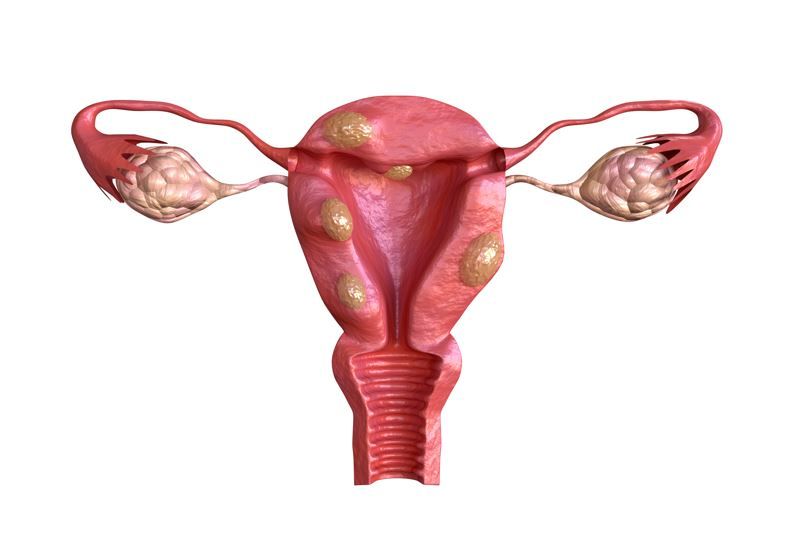- Clinical Technology
- Adult Immunization
- Hepatology
- Pediatric Immunization
- Screening
- Psychiatry
- Allergy
- Women's Health
- Cardiology
- Pediatrics
- Dermatology
- Endocrinology
- Pain Management
- Gastroenterology
- Infectious Disease
- Obesity Medicine
- Rheumatology
- Nephrology
- Neurology
- Pulmonology
Untreated, New-Onset Hypertension Tied to Higher Risk of Uterine Fibroids in Women
Women with new-onset HTN faced a 45% greater risk of newly self-reported fibroids and those with untreated HTN had a 19% greater risk, according to a new study.

In a new study of over 2500 women at midlife, results showed participants with new-onset hypertension (HTN) faced a 45% greater risk of newly self-reported fibroids and those with untreated HTN had a 19% greater risk, whereas those taking antihypertensive medication had a 37% lower risk.
In addition, cardiovascular risk factors including anthropometry and blood biomarkers were not associated with risk of newly developed fibroids, according to findings published April 16, 2024, in JAMA Network Open.
“These findings motivate investigation into the mechanisms underlying fibroids and may lead to new strategies for their prevention,” wrote first author Susanna Mitro, PhD, of Kaiser Permanente Northern California in Oakland, and colleagues.
Uterine fibroids are benign neoplasms that are associated with severe gynecologic morbidity, according to researchers. Fibroids occur in 70% to 80% of women by age 50 years, however, there are no available strategies to prevent them.
“Growing evidence suggests that hypertension and other cardiovascular risk factors (including cholesterol levels, anthropometric measurements, carotid intima-media thickness, ankle-brachial index, and body composition) may be associated with fibroids. However, most studies have been cross-sectional, precluding analysis of temporality,” wrote Mitro and colleagues.
While prior prospective studies have suggested an association between HTN and other cardiovascular risk factors and fibroids, the evidence has been limited and based on self-reported measures and diagnoses, researchers observed, making findings subject to reporting errors.
“Prospective longitudinal studies with criterion-standard risk factor ascertainment are needed to elucidate potential associations between hypertension, markers of cardiovascular risk, and fibroids,” added investigators. They conducted the current study using data from a racially and ethnically diverse prospective cohort, the Study of Women’s Health Across the Nation (SWAN; n=3302), to examine whether measured HTN, antihypertensive agents, and additional cardiovascular risk factors were associated with new fibroid diagnosis in midlife.
SWAN participants were followed from enrollment (1996-1997) through 13 semiannual visits (1998-2012). Eligible participants had a menstrual period in the 3 months prior to enrollment, were not pregnant or lactating, were aged 42 to 52 years, were not using hormones, and had a uterus and at least 1 ovary. Participants were excluded if they had a prior fibroid diagnosis. Data analysis was performed from November 2022 to February 2024, according to the study.
Investigators measured blood pressure, anthropometry, biomarkers (cholesterol, triglycerides, and high-sensitivity C-reactive protein [hsCRP]), and self-reported antihypertensive treatment at baseline and follow-up visits. HTN status categories included new-onset, preexisting, or never (reference group) and HTN treatment was categorized as untreated, treated, or no HTN (reference group).
The main outcome was participant-reported fibroid diagnosis at each visit, added researchers.
FINDINGS
A total of 2570 women (mean age, 45 years; 54.8% premenopausal) were included in the study, among whom 25.4% were Black, 48.9% were White, 8.3% were Chinese, 9.1% were Hispanic, and 8.7% were Japanese. Over follow-up, 20% of participants reported a new diagnosis of fibroids, according to the results.
Researchers observed that the risk of developing fibroids varied by HTN status and HTN treatment category. Participants with new-onset HTN had a 45% higher risk of new reported fibroid diagnosis (HR 1.45, 95% CI 0.96-2.20) compared with never-hypertensive participants, whereas those with preexisting HTN did not have higher risk. Similarly, women with untreated HTN faced a 19% greater risk of newly self-reported fibroids (HR 1.19, 95% CI 0.91-1.57) compared with those with no HTN, while those with treated HTN had a 20% lower risk (HR 0.80, 95% CI, 0.56-1.15).
Among eligible participants with HTN, those taking antihypertensive medication had a 37% lower risk of new reported fibroid diagnosis (HR 0.63, 95% CI 0.38-1.05). This decrease in risk was particularly pronounced among women using ACE inhibitors compared with those using no antihypertensive treatment (48% lower risk; HR 0.52, 95% CI 0.27-1.00), noted researchers.
Investigators did not find an association between anthropometry, lipids, and hsCRP and risk of newly reported fibroid diagnosis.
“Investigation into mechanisms and health implications is warranted; if the associations are causal, antihypertensive medication use where indicated may present an opportunity to prevent clinically apparent fibroid development at this high-risk life stage,” concluded Mitro et al.
Source: Mitro SD, Wise LA, Waetjen LE, et al. Hypertension, cardiovascular risk factors, and uterine fibroid diagnosis in midlife. JAMA Netw Open. 2024;7:e246832. doi:10.1001/jamanetworkopen.2024.6832
